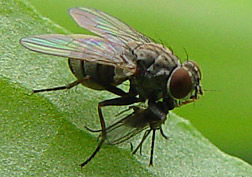This page has been archived and is being provided for reference purposes only. The page is no longer being updated, and therefore, links on the page may be invalid.
|
Read the magazine story to find out more. |
|
|
A Fly, New to North America, Hunts Down Greenhouse Pests
By Luis PonsOctober 6, 2005
Insects in North American greenhouses had best beware: There's a new predator among them.
Agricultural Research Service (ARS) scientists have helped Cornell University colleagues make the first-ever identification on this continent of the Old World hunter fly, Coenosia attenuata.
This winged predator is originally from Europe, where it's also known as the "killer fly." A member of the same insect family as the common housefly (Muscidae), the Old World hunter fly preys upon some of the insects that greenhouse keepers hate the most. These include fungus gnats, shore flies, leafminers, fruit flies, moth flies and some leafhoppers.
The Old World hunter fly's presence here was confirmed in studies by Cornell graduate student Emily Sensenbach, under the direction of ecologist Steve Wraight of ARS' Plant Protection Research Unit (PPRU) and associate professor John Sanderson. The PPRU is located on Cornell's Ithaca, N.Y., campus.
According to Wraight, this particular fly lives up to its name—and not just because it preys upon other flying insects. Apparently, it enjoys a challenge.
It sits, waits and only pursues prey that is in flight. When it catches its target, the fly punctures it with a daggerlike mouthpart and consumes the liquid inside. Its soil-dwelling larvae are also predatory, feeding mainly on larvae of other insects.
This fly was first noticed in the United States in 1999 in Onondaga County, N.Y. Wraight is not certain exactly how it got to the New World, but suspects that the horticulture industry played a role.
He added that the fly was seen in South America, southern Asia, Africa, the Canary Islands, New Guinea and Australia before being identified here.
According to Wraight, there is considerable potential for using hunter flies in biological control of insect pests.
Read more about the hunter fly research, which is funded through the U.S. Department of Agriculture's Floriculture and Nursery Research Initiative, in the October issue of Agricultural Research magazine.
ARS is the USDA's chief in-house scientific research agency.

